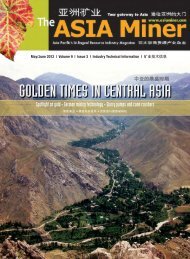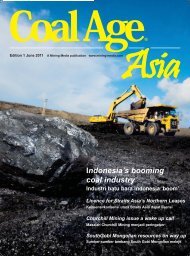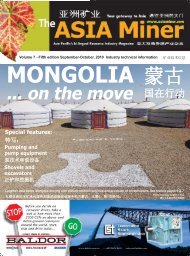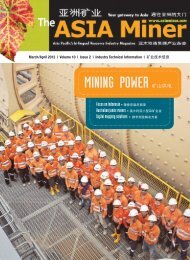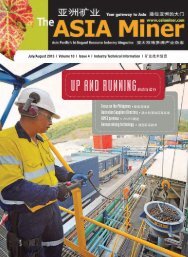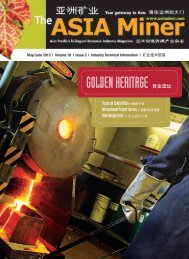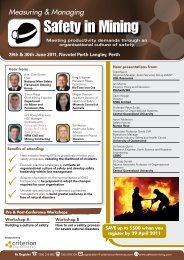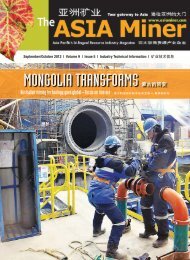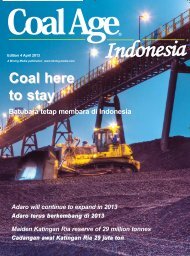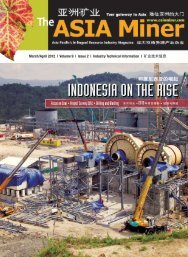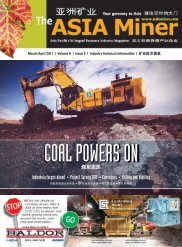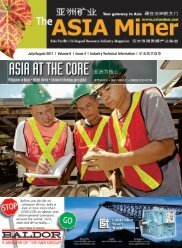MINING WELCOME 欢迎采矿 - The ASIA Miner
MINING WELCOME 欢迎采矿 - The ASIA Miner
MINING WELCOME 欢迎采矿 - The ASIA Miner
You also want an ePaper? Increase the reach of your titles
YUMPU automatically turns print PDFs into web optimized ePapers that Google loves.
Asian Intelligence<br />
Australia can reclaim technology mantle<br />
AUSTRALIA’S resources sector has taken its<br />
eye off the ball in developing world-leading<br />
mining, energy and exploration technology,<br />
according to one of the sector’s most prominent<br />
female identities, and it is due mainly to<br />
the speed and intensity in which the industry<br />
has grown over the past five years.<br />
However, an opportunity exists over the next<br />
30 years for the sector to reclaim that mantle<br />
and ‘do things better than anywhere else in the<br />
world’. <strong>The</strong> comments were made by respected<br />
industry stalwart Dr Erica Smyth in delivering the<br />
37th annual Essington Lewis Memorial Lecture,<br />
one of the most prestigious lectures on the<br />
South Australian resources industry calendar.<br />
“<strong>The</strong>re is an opportunity for us to do our<br />
business better than anywhere else in the<br />
world, and in doing so, create a long-lasting<br />
legacy of a skills and knowledge node for the<br />
resources sector,” she said. “We need to harness<br />
the research, new business investment,<br />
technology innovation, local training and skills<br />
development that are now going on in a piecemeal<br />
way. This approach will need to be<br />
via government, universities and resource industry<br />
collaborations and partnerships.<br />
“<strong>The</strong> industry has grown at such a rapid rate<br />
over the past 5 years no-one has actually had<br />
the time to sit down and look at the things we<br />
have done well, and the things we haven’t<br />
done so well. As we venture into this next period<br />
of growth, we need to be very careful that<br />
we leverage off the things we already do well<br />
and to make time to address our weaknesses.<br />
“Now, although we are not well known for<br />
our inventions, we are seen as innovators in<br />
applying that technology. Yes we have to import<br />
the electronics associated with the completion<br />
of production wells on the sea floor so<br />
that production could be safely controlled,<br />
but the way we apply that technology is first<br />
class. <strong>The</strong> oil and gas industry is indeed an<br />
international one where specialty components<br />
come in from all over the world – and<br />
then local Australian innovators make them<br />
work in our conditions. But we seem to have<br />
taken our eye off the ball as we rush to meet<br />
the needs of the rest of the world. I am particularly<br />
concerned that we do not seem to<br />
have a vision other than to ‘dig it up and ship<br />
it out’. We seem to have left the grassroots,<br />
expensive and often unsuccessful, research<br />
to others and rely on our ability to innovate in<br />
its application.”<br />
Power, water and roads vital for South Gobi<br />
THE supply of power, increased paved road<br />
capacity and sourcing more reliable water<br />
have been named by the Government of Mongolia<br />
as the most pressing issues to be solved<br />
in ongoing development of the South Gobi region.<br />
A cabinet meeting issued a resolution regarding<br />
these issues as well as planning for<br />
settlements and border crossings.<br />
Within the framework of this resolution,<br />
which primarily concerns development of the<br />
Oyu Tolgoi (OT) and Tavan Tolgoi (TT) mines,<br />
the following measures are to be taken:<br />
• Supply power consumption for current<br />
and future productive development<br />
• Increase capacity of paved road by making<br />
it a four-lane road<br />
• Increase water source required for development<br />
of mining and infrastructure<br />
• Approval of master plans for soums/villages;<br />
of border crossing points Gashuun<br />
Sukhait/Gantsimadao and Shivee Khuren/Ceke;<br />
and soum centres Khanbogd<br />
(OT), Tsogttsetsii (TT) and Gurvantes/Nariin<br />
Sukhait.<br />
With power the Erdenes TT (ETT) company<br />
has been assigned to undertake a feasibility<br />
Mongolian Mining Corporation’s recently completed paved road to the Gashuun Sukhait border crossing is an example<br />
of the infrastructure needed in the South Gobi region.<br />
study for a power plant to be constructed<br />
based on TT and with a build-operate-transfer<br />
(BOT) condition to the state. <strong>The</strong> OT company<br />
has been assigned responsibility to<br />
build a power plant to supply production’s<br />
consumption with a condition not to impact<br />
the budget cost, a BOT condition to the state<br />
and a condition for the plant to use TT coal.<br />
With roads the capacity of the 245km paved<br />
road from TT to the Gashuun Sukhait border<br />
crossing is to be increased. ETT has been assigned<br />
responsibility to increase the width from<br />
two lanes to four, to secure funding source for<br />
the new lanes on a BOT basis and have other<br />
investors participate in the construction. <strong>The</strong><br />
government also wants roads from South Gobi<br />
to the Khangi Mandal and Zamyn Uud border<br />
crossings to be researched.<br />
<strong>The</strong> government says significant water resources<br />
are required for the development of<br />
mining and infrastructure. <strong>The</strong> sector’s minister,<br />
related agencies and provincial governors<br />
have been assigned the task to make<br />
detailed hydrogeological exploration at areas<br />
with underground accumulation at TT and in<br />
the Sainshand vicinity.<br />
<strong>The</strong>y are also to start a study for the possibility<br />
of making flow adjustments to the Orkhon<br />
and Selenge rivers, and establishing a<br />
reservoir with a view to start construction in<br />
2013. ETT is also to use water from the underground<br />
deposit at Balgas Ulaan lake.<br />
4 | <strong>ASIA</strong> <strong>Miner</strong> | January/February 2012



